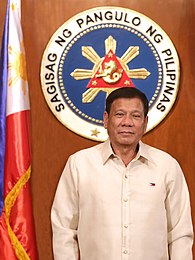Philippine president
| President of the Philippines Pangulo ng Pilipinas |
|
|---|---|

|
|

|
|
| Style |
Mr. President (Informal) His Excellency (Formal) |
| Member of |
Cabinet National Security Council |
| Residence | Malacañang Palace |
| Seat | Manila, Philippines |
| Term length | Six years unrenewable |
| Constituting instrument | 1987 Constitution of the Philippines |
| Inaugural holder |
Emilio Aguinaldo (official)a Manuel L. Quezon (de jure)b |
| Formation | 23 January 1899 (official)a 15 November 1935 (de jure)b |
| Salary | ₱399,739 per month/ ₱4,796,868 per year |
| Website | www |
|
The President of the Philippines (Filipino: Pangulo ng Pilipinas) is the head of state and head of government of the Philippines. The President leads the executive branch of the Philippine government and is the commander-in-chief of the Armed Forces of the Philippines.
Filipinos refer to their President as Pangulo or Presidente. The President serves a single, fixed, six-year term without possibility of re-election.
In Filipino, one of the two official languages of the Philippines, the President is referred to as Pangulo. In the other major languages of the Philippines such as the Visayan languages, Presidente is more common when Filipinos are not actually code-switching with the English word.
Depending on the definition chosen for these terms, a number of persons could alternatively be considered the inaugural holder of the office. Andrés Bonifacio could be considered the first President of a united Philippines since he was the third Supreme President (Spanish: Presidente Supremo; Filipino: Kataas-taasang Pangulo) of the Katipunan, a secret revolutionary society. Its Supreme Council, led by the Supreme President, coordinated provincial and district councils. When the Katipunan started an open revolt against the Spanish colonial government in August 1896, Bonifacio transformed the society into a revolutionary government with him as its head. While the term Katipunan remained, Bonifacio's government was also known as the Tagalog Republic (Spanish: República Tagala; Filipino: Republikang Tagalog). Although the word Tagalog refers to the Tagalog people, a specific ethno-linguistic group, Bonifacio used it to denote all non-Spanish peoples of the Philippines in place of Filipinos, which had colonial origins. Bonifacio's revolutionary government never controlled much territory for any significant period. Some historians contend that including Bonifacio as a past president would imply that Macario Sacay and Miguel Malvar should also be included.
...
Wikipedia

